The German Westerm Winnetou – 2. Teil/Last of the Renegades (Harald Reinl, 1964), also known as Winnetou: The Red Gentleman, is one of the Eurowesterns in the series based on the novels by Karl May. Stars are Pierre Brice as Apache chief Winnetou and Lex Barker as his soul mate Old Shatterhand.
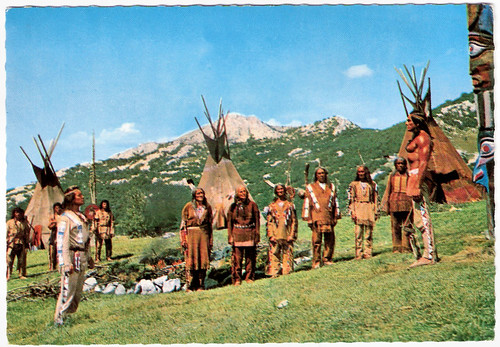
German postcard, no. R 5. Photo: publicity still of Pierre Brice and Gojko Mitic in Winnetou II. Teil/Winnetou: The Red Gentleman (Harald Reinl, 1964). Caption: "Winnetou hat die Assiniboins für seine Pläne gewonnen, und man beschliesst eine Verhandlung mit den Weissen in Fort Niobara. Botschaft hierüber geht an alle Häuptlinge." (Winnetou has won the Assiniboins for his plans, and they choose for a negotiation with the white in Fort Niobara. This message goes to all chiefs.)
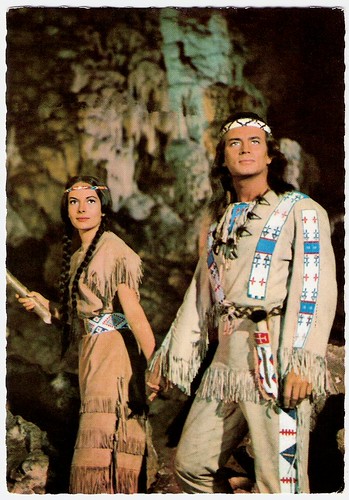
German postcard, no. R 7. Photo: still from Winnetou II. Teil/Last of the Renegades (Harald Reinl, 1964) with Karin Dor as Ribanna and Pierre Brice as Winnetou. Caption: "Ribanna lüftet ein Geheimnis. Sie zeigt Winnetou eine im Felsen verborgene Höhle, die in Kriegszeiten den Frauen und Kinder als Zuflkuchtsstätte dient." (Ribanna reveals a secret. She shows Winnetou a cave hidden in the rock, which in wartime serves the women and children as a refuge.)

German postcard, no R 8. Photo: publicity still for Winnetou II. Teil/Winnetou: The Red Gentleman (Harald Reinl, 1964) with Pierre Brice and Karin Dor. Caption: "Noch ahnt man nicht, wie bald von diesem Versteck Gebrauch gemacht werden muss; den Forrester, der sein dunkles Gerwerbe auf Kosten der Indianer betreibt, schmiedet schon Pläne." (Yet nobody suspects how soon this hiding place must be used; Forrester, who runs his shady business at the expense of the Indians, already makes his plans).
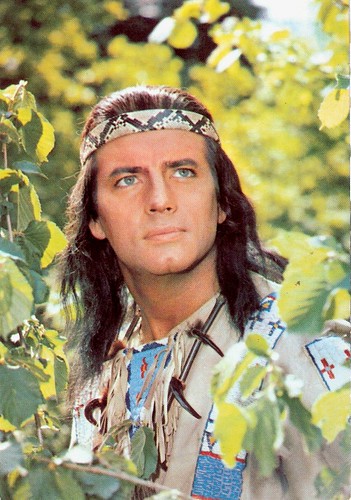
German postcard by ISV, no. R 14. Photo: publicity still for Winnetou II. Teil/Last of the Renegades (Harald Reinl, 1964) with Pierre Brice as Winnetou. Caption: "In letzter Minute rettet Winnetou seinen Blutsbruder Old Shatterhand aus den Flammen." (At the last minute Winnetou saves his blood brother Old Shatterhand from the flames)
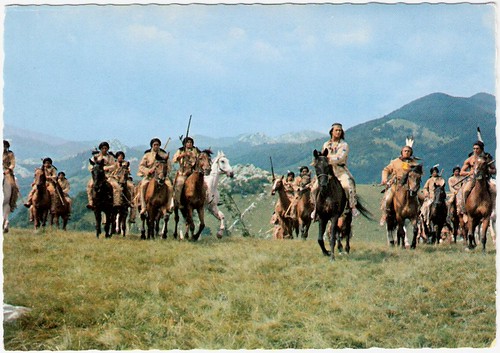
German postcard, no. R 15. Photo: still from Winnetou II (Harald Reinl, 1964) with Pierre Brice. Caption: "Winnetou, Old Shatterhand und die anderen Indianerhäuptlinge reiten zur Friedenskonferenz nach Fort Niobrara." (Winnetou, Old Shatterhand and the other Indian Chiefs ride to Fort Niobrara for the peace conference.)
In the aftermath of the Second World War, Europe was left in ruins and so was the European cinema, especially the German film industry. There was a strong backlash against those filmmakers who had remained faithful to the Nazi party, while many of Germany's best filmmakers had moved to America in the 1930s.
In the 1950s, the German cinema struggled gradually back to form. Low budgets and at first a lack of international markets were the reasons that the most popular productions were the Heimat films and later also the Sissi films with Romy Schneider. Large audience figures meant that the film studios were gradually able to increase their budgets, and by the 1960s, big scale films were back on the cards. And even some of the directors who had fled to Hollywood returned to work in Germany, including Fritz Lang.
The Karl May novels were, and still are highly popular in the German speaking world, telling of adventurous exploits in the Wild West, the Orient. Film adaptations of the books had been made as early as the 1920s, and again in the late 1930s, and discussions had been made about shooting some of the Wild West stories - indeed a final script for a Winnetou film was approved in 1944 by Propaganda Minister Joseph Goebbels but never went into production.
Timothy Young in his Mondo Esoterica Guide to: The Karl May Westerns: "With German audiences filling cinemas, and desperately wanting more home grown films, the Karl May themes seemed like a perfect money spinner for producer Horst Wendlandt. A key player at Rialto Film, he had successfully produced a series of adult-targeted films based on the Edgar Wallace thriller/horror novels."
Wendlandt now sought to target the younger markets. His idea of shooting European Westerns was unheard of at the beginning of the 1960s - the Spaghetti Western rage started only a few years later with Sergio Leone's Per un pugno di dollari/For a fistful of Dollars (1964).
Instead of using the Spanish locations of the Spaghetti Westerns, the Karl May series was shot in Yugoslavia. Films like Winnetou II. Teil (1964) took great advantage of the barren landscapes, mountains and rivers. In return, the films made Yugoslavia a popular holiday destination for many Europeans.
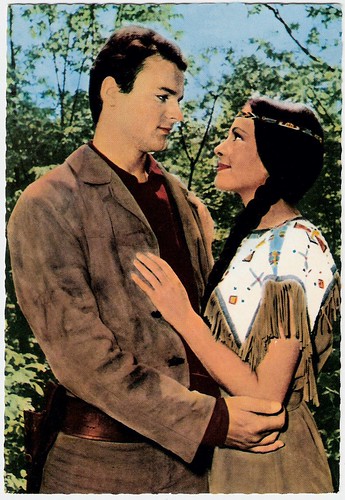
German postcard, no. R 16. Photo: publicity still from Winnetou II. Teil/Last of the Renegades (Harald Reinl, 1964) with Mario Girotti and Karin Dor. Caption: "Fast scheitern die Friedensverhandlungen. Da erklärt sich Leutnant Merril bereit, Ribanna zu heiraten, um den Friedensband zwischen Weiss und Rot zu besieglen." (Almost the peace negotiations are failing. Lieutenant Merril declares his willingness to marry Ribanna in order to conquer the peace bond between white and red.)

German postcard, no. R 17. Photo: publicity still for Winnetou II. Teil/Winnetou: The Red Gentleman (Harald Reinl, 1964) with Pierre Brice and Karin Dor. Caption: So werden Ribanna und Winnetou gezwungen, ihre Liebe dem Frieden zu opfern. (Thus Ribanna and Winnetou are forced to sacrifice their love.)
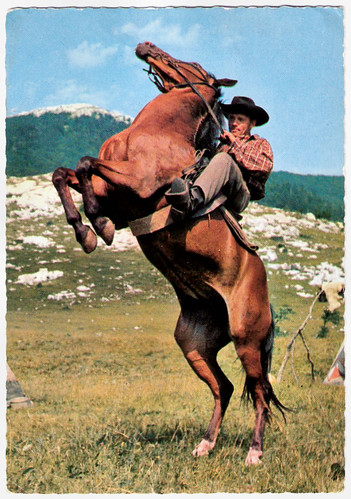
German postcard, no. R 18. Photo: publicity still for Winnetou II. Teil/Winnetou: The Red Gentleman (Harald Reinl, 1964). Caption: "Forrester sorgt für Unfrieden. Er überfällt mit seiner Bande einen Siedlertreck und hinterlässt falsche Spuren, um die Indianer in den Verdacht dieser Untat zu bringen." (Forrester is a source of dissatisfaction. He crosses a settlement with his gang, leaving behind bad traces to bring the Indians into the suspicion of this misdeed.)

German postcard, no. R 19. Photo: still from Winnetou - II. Teil/Last of the Renegades (Harald Reinl, 1964) with Karin Dor as Ribanna. Caption: "Den Assiniboins droht Gefahr. Von Ribanna und Leutnant Merril gewarnt, werden die Frauen und Kinder noch rechtzeitig in die Höhle geführt." (The Assiniboin are in danger. Warned by Ribanna and lieutenant Merril, the women and children are led into the cave in time.)
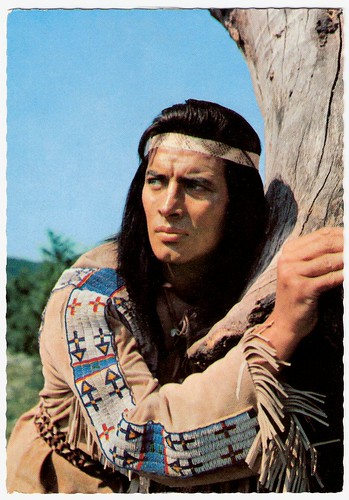
German postcard, no. R 20. Photo: publicity still for Winnetou II. Teil/Last of the Renegades (Harald Reinl, 1964) with Pierre Brice. Caption: Auf der Suche nach Forrester geraten Winnetou und Old Shatterhand in einen Hinterhalt. Durch eine List können sie in letzter Minute entkommen. (Looking for Forrester Winnetou and Old Shatterhand fall into an ambush. By a trick they can escape at the last minute.)
Horst Wendlandt's first Eurowestern was, appropriately enough, Karl May's first Old West book - Der Schatz im Silbersee/The Treasure of Silver Lake (Harald Reinl, 1962). The novel had to be altered for the screen - scenes set aboard an American paddle steamer proved too much for the budget, while the graphic details of Colonel Brinkley's savage nature had to be toned down for the family market - but it still retained the charm and feel of the original stories, and proved a massive hit with audiences across Germany.
Impressively, the distinctive soundtrack proved equally popular and became a bestseller. The studio quickly commissioned a second film, and following the order of the original books Rialto produced the prequel story Winnetou 1. Teil (1963) which told the origins of the Winnetou and Old Shatterhand characters who played the major role in Der Schatz im Silbersee/The Treasure of Silver Lake, it secured actors Lex Barker and Pierre Brice in their respective roles as Old Shatterhand and Winnetou.
According to Timothy Young at the Mondo Esoterica Guide, Winnetou 1. Teil/Apache Gold (Harald Reinl, 1963) proved equally popular to the first, and stands as the best in the series - boasting a rarely bettered set piece with a full scale railway locomotive being driven through a saloon building.
Winnetou II. Teil (1964) followed on, continuing the series' popularity. Again Harald Reinl directed the sequel and he could work with a very good script by veteran author Harald G. Petterson. Composer Martin Böttcher made a new lead theme, the Winnetou-Melodie, which became massive hit.
Lex Barker and Pierre Brice were joined by a cast of excellent actors. Karin Dor plays Winnetou's greatest love Ribanna, British actor Anthony Steel plays Forester, a ruthless oil baron, and among his gang members is the enigmatic Klaus Kinski.
Lt. Robert Merril, one of the good guys is played by a blue-eyed Italian hunk called Mario Girotti, who would become one of the best-known Spaghetti Western stars under the alias Terence Hill. Also remarkable is the small part of Gojko Mitic as White Bird. The muscled Yugoslavian actor later became the superstar of the Eastern, the East-European Western. Finally there is comic actor Eddi Arent as Old Shatterhand's sidekick Lord Castlepool.
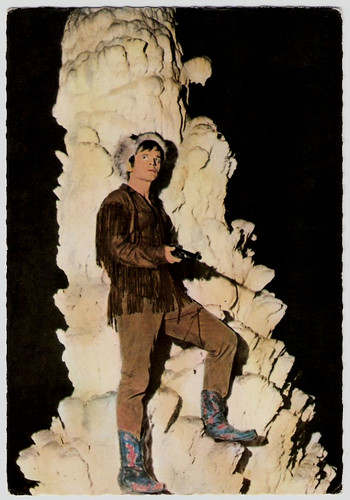
German postcard, no. R 21. Photo: publicity still for Winnetou - 2. Teil/Last of the Renegades (Harald Reinl, 1964), with Klaus Kinski. Caption: "Mit Hilfe des Bandesmitgliedes Luke spüren die Verbrecher die Höhle auf und bemächtigen sich der Frauen und Kinder des Assiniboins." (With the help of band member Luke the criminals find the cave and take possession of the women and children of the Assiniboin.)
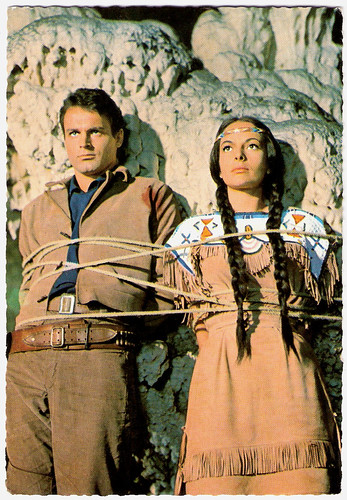
German postcard, no. R 22. Photo: publicity still for Winnetou - 2. Teil/Last of the Renegades (Harald Reinl, 1964) with Mario Girotti and Karin Dor. Caption: "Auch Ribanna und ihr Mann Leutnant Merrill fallen in die Hände der Bande. Sie werden als Gefangene an einen Felsen gebunden." (Ribanna and her husband Lt. Merrill also fall into the hands of the gang. They are bound as prisoners to a rock.)
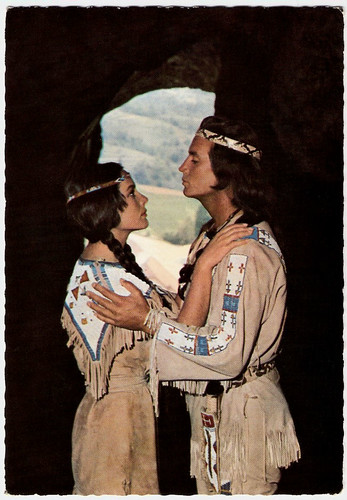
German postcard, no. R 24. Photo: still from Winnetou II. Teil/Last of the Renegades (Harald Reinl, 1964) with Karin Dor as Ribanna and Pierre Brice as Winnetou. Caption: "Bis zur Verhandlung weilt Winnetou bei den Assiniboins und lernt Ribanna näher kennen und lieben." (Winnetou is waiting for the Assiniboins and learns to know and love Ribanna.)
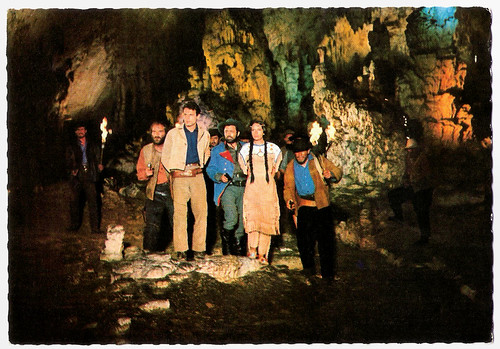
German postcard, no. R 26. Photo: publicity still for Winnetou 2. Teil/Winnetou: The Red Gentleman (Harald Reinl, 1964) with Mario Girotti, Karin Dor and Anthony Steel. Caption: "Der Skrupellose Forrester benutzt Ribanna und Leutnant Merril als Geiseln. Die Bande verlangt freien Abzug." (The unscrupulous Forrester used Ribanna and Lieutenant Merril as hostages. The gang demanded free passage.)
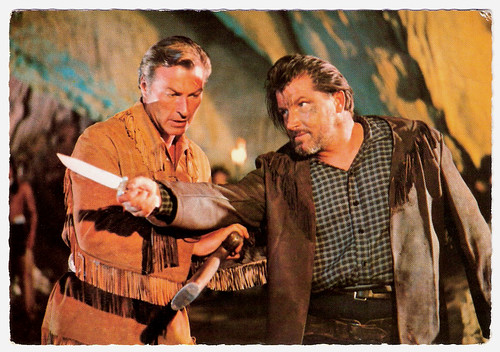
German postcard, no. R 27. Photo: publicity still for Winnetou II. Teil/Winnetou: The Red Gentleman (Harald Reinl, 1964) with Lex Barker as Old Shatterhand. Caption: "Durch einen Unterirdischen Wasserlauf gelingt es den Rettern in die Höhle einzudringen. Old Shatterhands harte Fäuste räumen unter den Banditen auf." (Through an underground watercourse the rescuers succeed to penetrate into the cave. Old Shatterhand's hard fists cleave under the bandits.)
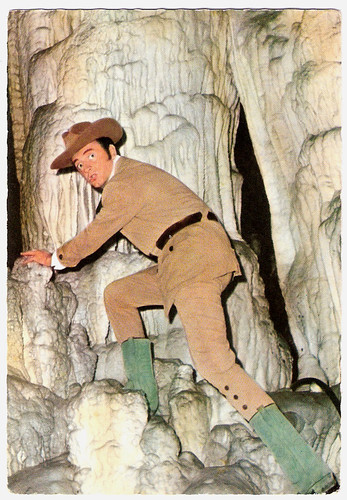
German postcard, no. R 28. Photo: publicity still for Winnetou II. Teil/ Last of the Renegades (Harald Reinl, 1964) with Eddi Arent. Caption: "Auch Lord Castlepool, der sich aus Abenteurlust Old Shatterhand angeschlossen hat, bewährt sich am Kampf gegen die Banditen." (Lord Castlepool, who has joined Old Shatterhand lusting for adventures, is also fighting against the bandits.)
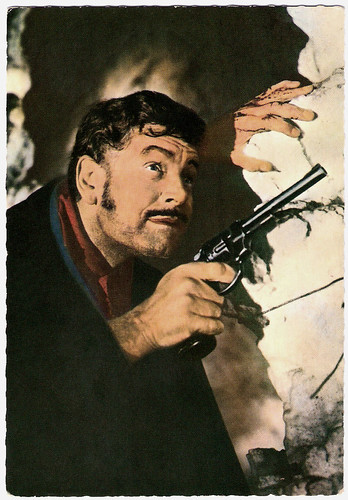
German postcard, no. R 29. Photo: publicity still for Winnetou - 2. Teil/Last of the Renegades (Harald Reinl, 1964) with Anthony Steel. Caption: "Die Bande ist vernichtet. Nur Forrester kämpft noch um sein Leben.Jedoch entgeht er nicht seinem wohlverdienten Schicksal." (The gang is destroyed. Only Forrester is still struggling for his life. However, he does not escape his well-deserved destiny.)
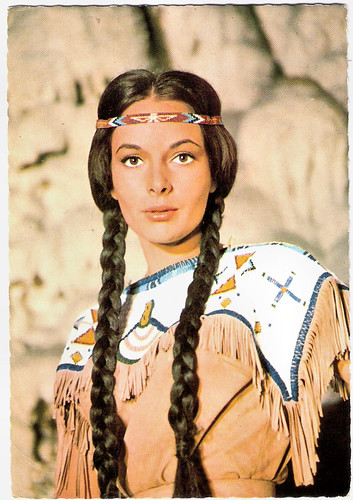
German postcard, no. R 30. Photo: publicity still for Winnetou 2. Teil/Winnetou: The Red Gentleman (Harald Reinl, 1964) with Karin Dor. Caption: "Der Friede ist gerettet. Ribanna weiss, dass ihr und Winnetous Opfer nicht umsonst war." (Peace is saved. Ribanna knows that her and Winnetou's sacrifice was not in vain.)
Sources: Timothy Young (Mondo Esoterica Guide to: The Karl May Westerns), Wikipedia (German and English) and IMDb.

German postcard, no. R 5. Photo: publicity still of Pierre Brice and Gojko Mitic in Winnetou II. Teil/Winnetou: The Red Gentleman (Harald Reinl, 1964). Caption: "Winnetou hat die Assiniboins für seine Pläne gewonnen, und man beschliesst eine Verhandlung mit den Weissen in Fort Niobara. Botschaft hierüber geht an alle Häuptlinge." (Winnetou has won the Assiniboins for his plans, and they choose for a negotiation with the white in Fort Niobara. This message goes to all chiefs.)

German postcard, no. R 7. Photo: still from Winnetou II. Teil/Last of the Renegades (Harald Reinl, 1964) with Karin Dor as Ribanna and Pierre Brice as Winnetou. Caption: "Ribanna lüftet ein Geheimnis. Sie zeigt Winnetou eine im Felsen verborgene Höhle, die in Kriegszeiten den Frauen und Kinder als Zuflkuchtsstätte dient." (Ribanna reveals a secret. She shows Winnetou a cave hidden in the rock, which in wartime serves the women and children as a refuge.)

German postcard, no R 8. Photo: publicity still for Winnetou II. Teil/Winnetou: The Red Gentleman (Harald Reinl, 1964) with Pierre Brice and Karin Dor. Caption: "Noch ahnt man nicht, wie bald von diesem Versteck Gebrauch gemacht werden muss; den Forrester, der sein dunkles Gerwerbe auf Kosten der Indianer betreibt, schmiedet schon Pläne." (Yet nobody suspects how soon this hiding place must be used; Forrester, who runs his shady business at the expense of the Indians, already makes his plans).

German postcard by ISV, no. R 14. Photo: publicity still for Winnetou II. Teil/Last of the Renegades (Harald Reinl, 1964) with Pierre Brice as Winnetou. Caption: "In letzter Minute rettet Winnetou seinen Blutsbruder Old Shatterhand aus den Flammen." (At the last minute Winnetou saves his blood brother Old Shatterhand from the flames)

German postcard, no. R 15. Photo: still from Winnetou II (Harald Reinl, 1964) with Pierre Brice. Caption: "Winnetou, Old Shatterhand und die anderen Indianerhäuptlinge reiten zur Friedenskonferenz nach Fort Niobrara." (Winnetou, Old Shatterhand and the other Indian Chiefs ride to Fort Niobrara for the peace conference.)
A perfect money spinner
In the aftermath of the Second World War, Europe was left in ruins and so was the European cinema, especially the German film industry. There was a strong backlash against those filmmakers who had remained faithful to the Nazi party, while many of Germany's best filmmakers had moved to America in the 1930s.
In the 1950s, the German cinema struggled gradually back to form. Low budgets and at first a lack of international markets were the reasons that the most popular productions were the Heimat films and later also the Sissi films with Romy Schneider. Large audience figures meant that the film studios were gradually able to increase their budgets, and by the 1960s, big scale films were back on the cards. And even some of the directors who had fled to Hollywood returned to work in Germany, including Fritz Lang.
The Karl May novels were, and still are highly popular in the German speaking world, telling of adventurous exploits in the Wild West, the Orient. Film adaptations of the books had been made as early as the 1920s, and again in the late 1930s, and discussions had been made about shooting some of the Wild West stories - indeed a final script for a Winnetou film was approved in 1944 by Propaganda Minister Joseph Goebbels but never went into production.
Timothy Young in his Mondo Esoterica Guide to: The Karl May Westerns: "With German audiences filling cinemas, and desperately wanting more home grown films, the Karl May themes seemed like a perfect money spinner for producer Horst Wendlandt. A key player at Rialto Film, he had successfully produced a series of adult-targeted films based on the Edgar Wallace thriller/horror novels."
Wendlandt now sought to target the younger markets. His idea of shooting European Westerns was unheard of at the beginning of the 1960s - the Spaghetti Western rage started only a few years later with Sergio Leone's Per un pugno di dollari/For a fistful of Dollars (1964).
Instead of using the Spanish locations of the Spaghetti Westerns, the Karl May series was shot in Yugoslavia. Films like Winnetou II. Teil (1964) took great advantage of the barren landscapes, mountains and rivers. In return, the films made Yugoslavia a popular holiday destination for many Europeans.

German postcard, no. R 16. Photo: publicity still from Winnetou II. Teil/Last of the Renegades (Harald Reinl, 1964) with Mario Girotti and Karin Dor. Caption: "Fast scheitern die Friedensverhandlungen. Da erklärt sich Leutnant Merril bereit, Ribanna zu heiraten, um den Friedensband zwischen Weiss und Rot zu besieglen." (Almost the peace negotiations are failing. Lieutenant Merril declares his willingness to marry Ribanna in order to conquer the peace bond between white and red.)

German postcard, no. R 17. Photo: publicity still for Winnetou II. Teil/Winnetou: The Red Gentleman (Harald Reinl, 1964) with Pierre Brice and Karin Dor. Caption: So werden Ribanna und Winnetou gezwungen, ihre Liebe dem Frieden zu opfern. (Thus Ribanna and Winnetou are forced to sacrifice their love.)

German postcard, no. R 18. Photo: publicity still for Winnetou II. Teil/Winnetou: The Red Gentleman (Harald Reinl, 1964). Caption: "Forrester sorgt für Unfrieden. Er überfällt mit seiner Bande einen Siedlertreck und hinterlässt falsche Spuren, um die Indianer in den Verdacht dieser Untat zu bringen." (Forrester is a source of dissatisfaction. He crosses a settlement with his gang, leaving behind bad traces to bring the Indians into the suspicion of this misdeed.)

German postcard, no. R 19. Photo: still from Winnetou - II. Teil/Last of the Renegades (Harald Reinl, 1964) with Karin Dor as Ribanna. Caption: "Den Assiniboins droht Gefahr. Von Ribanna und Leutnant Merril gewarnt, werden die Frauen und Kinder noch rechtzeitig in die Höhle geführt." (The Assiniboin are in danger. Warned by Ribanna and lieutenant Merril, the women and children are led into the cave in time.)

German postcard, no. R 20. Photo: publicity still for Winnetou II. Teil/Last of the Renegades (Harald Reinl, 1964) with Pierre Brice. Caption: Auf der Suche nach Forrester geraten Winnetou und Old Shatterhand in einen Hinterhalt. Durch eine List können sie in letzter Minute entkommen. (Looking for Forrester Winnetou and Old Shatterhand fall into an ambush. By a trick they can escape at the last minute.)
Winnetou's greatest love
Horst Wendlandt's first Eurowestern was, appropriately enough, Karl May's first Old West book - Der Schatz im Silbersee/The Treasure of Silver Lake (Harald Reinl, 1962). The novel had to be altered for the screen - scenes set aboard an American paddle steamer proved too much for the budget, while the graphic details of Colonel Brinkley's savage nature had to be toned down for the family market - but it still retained the charm and feel of the original stories, and proved a massive hit with audiences across Germany.
Impressively, the distinctive soundtrack proved equally popular and became a bestseller. The studio quickly commissioned a second film, and following the order of the original books Rialto produced the prequel story Winnetou 1. Teil (1963) which told the origins of the Winnetou and Old Shatterhand characters who played the major role in Der Schatz im Silbersee/The Treasure of Silver Lake, it secured actors Lex Barker and Pierre Brice in their respective roles as Old Shatterhand and Winnetou.
According to Timothy Young at the Mondo Esoterica Guide, Winnetou 1. Teil/Apache Gold (Harald Reinl, 1963) proved equally popular to the first, and stands as the best in the series - boasting a rarely bettered set piece with a full scale railway locomotive being driven through a saloon building.
Winnetou II. Teil (1964) followed on, continuing the series' popularity. Again Harald Reinl directed the sequel and he could work with a very good script by veteran author Harald G. Petterson. Composer Martin Böttcher made a new lead theme, the Winnetou-Melodie, which became massive hit.
Lex Barker and Pierre Brice were joined by a cast of excellent actors. Karin Dor plays Winnetou's greatest love Ribanna, British actor Anthony Steel plays Forester, a ruthless oil baron, and among his gang members is the enigmatic Klaus Kinski.
Lt. Robert Merril, one of the good guys is played by a blue-eyed Italian hunk called Mario Girotti, who would become one of the best-known Spaghetti Western stars under the alias Terence Hill. Also remarkable is the small part of Gojko Mitic as White Bird. The muscled Yugoslavian actor later became the superstar of the Eastern, the East-European Western. Finally there is comic actor Eddi Arent as Old Shatterhand's sidekick Lord Castlepool.

German postcard, no. R 21. Photo: publicity still for Winnetou - 2. Teil/Last of the Renegades (Harald Reinl, 1964), with Klaus Kinski. Caption: "Mit Hilfe des Bandesmitgliedes Luke spüren die Verbrecher die Höhle auf und bemächtigen sich der Frauen und Kinder des Assiniboins." (With the help of band member Luke the criminals find the cave and take possession of the women and children of the Assiniboin.)

German postcard, no. R 22. Photo: publicity still for Winnetou - 2. Teil/Last of the Renegades (Harald Reinl, 1964) with Mario Girotti and Karin Dor. Caption: "Auch Ribanna und ihr Mann Leutnant Merrill fallen in die Hände der Bande. Sie werden als Gefangene an einen Felsen gebunden." (Ribanna and her husband Lt. Merrill also fall into the hands of the gang. They are bound as prisoners to a rock.)

German postcard, no. R 24. Photo: still from Winnetou II. Teil/Last of the Renegades (Harald Reinl, 1964) with Karin Dor as Ribanna and Pierre Brice as Winnetou. Caption: "Bis zur Verhandlung weilt Winnetou bei den Assiniboins und lernt Ribanna näher kennen und lieben." (Winnetou is waiting for the Assiniboins and learns to know and love Ribanna.)

German postcard, no. R 26. Photo: publicity still for Winnetou 2. Teil/Winnetou: The Red Gentleman (Harald Reinl, 1964) with Mario Girotti, Karin Dor and Anthony Steel. Caption: "Der Skrupellose Forrester benutzt Ribanna und Leutnant Merril als Geiseln. Die Bande verlangt freien Abzug." (The unscrupulous Forrester used Ribanna and Lieutenant Merril as hostages. The gang demanded free passage.)

German postcard, no. R 27. Photo: publicity still for Winnetou II. Teil/Winnetou: The Red Gentleman (Harald Reinl, 1964) with Lex Barker as Old Shatterhand. Caption: "Durch einen Unterirdischen Wasserlauf gelingt es den Rettern in die Höhle einzudringen. Old Shatterhands harte Fäuste räumen unter den Banditen auf." (Through an underground watercourse the rescuers succeed to penetrate into the cave. Old Shatterhand's hard fists cleave under the bandits.)

German postcard, no. R 28. Photo: publicity still for Winnetou II. Teil/ Last of the Renegades (Harald Reinl, 1964) with Eddi Arent. Caption: "Auch Lord Castlepool, der sich aus Abenteurlust Old Shatterhand angeschlossen hat, bewährt sich am Kampf gegen die Banditen." (Lord Castlepool, who has joined Old Shatterhand lusting for adventures, is also fighting against the bandits.)

German postcard, no. R 29. Photo: publicity still for Winnetou - 2. Teil/Last of the Renegades (Harald Reinl, 1964) with Anthony Steel. Caption: "Die Bande ist vernichtet. Nur Forrester kämpft noch um sein Leben.Jedoch entgeht er nicht seinem wohlverdienten Schicksal." (The gang is destroyed. Only Forrester is still struggling for his life. However, he does not escape his well-deserved destiny.)

German postcard, no. R 30. Photo: publicity still for Winnetou 2. Teil/Winnetou: The Red Gentleman (Harald Reinl, 1964) with Karin Dor. Caption: "Der Friede ist gerettet. Ribanna weiss, dass ihr und Winnetous Opfer nicht umsonst war." (Peace is saved. Ribanna knows that her and Winnetou's sacrifice was not in vain.)
Sources: Timothy Young (Mondo Esoterica Guide to: The Karl May Westerns), Wikipedia (German and English) and IMDb.
No comments:
Post a Comment